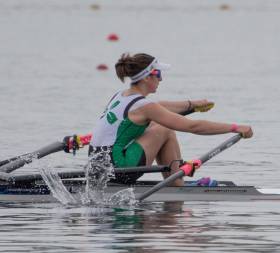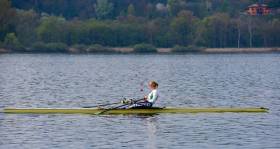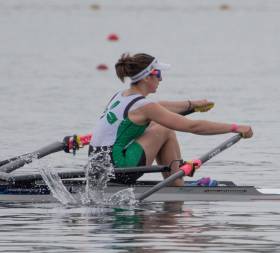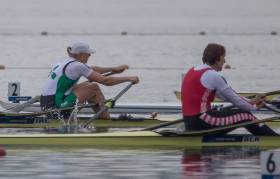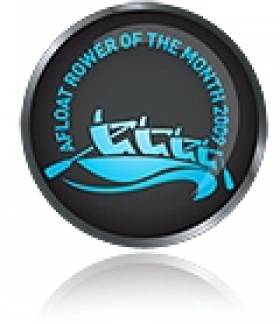Displaying items by tag: European Championships
#Rowing: Sanita Puspure took a bronze medal at the European Rowing Championships in Brandenburg in Germany, giving Ireland a second podium finish on a day in which the men’s lightweight double had taken gold. In awful conditions, Magdalena Lobnig of Austria took control of the race and won by almost 17 seconds from Elza Gulbe of Latvia, who took over second from Puspure when she missed a stroke at about 1600 metres. Puspure held off double Olympic champion Ekaterina Karsten, who was fourth.
European Rowing Championships, Brandenburg, Germany – Day Three (Irish interest; selected results):
Men
Lightweight Four – A Final: 2 Britain (4 P Chambers).
Lightweight Double Sculls – A Final: 1 Ireland (G O’Donovan, P O’Donovan) 6:57.76, 2 Germany 6:59.54, 3 Norway 7:00.52.
Lightweight Pair – A Final: 1 Britain (S Scrimgeour, J Cassells) 7:00.38, 2 Denmark 7:03.94, 3 Spain 7:05.32; 4 Ireland (M O’Donovan, S O’Driscoll) 7:09.67
Women
Quadruple Sculls – A Final: 5 Britain (3 H Nixon).
Lightweight Double Sculls – B Final (Places 7 to 12): 1 Sweden 7:27.70, 2 Britain 7:27.99, 3 Ireland (C Lambe, S Jennings) 7:30.28.
Single Sculls – A Final: 1 Austria (M Lobnig) 7:22.32, 2 Latvia (E Gulbe) 7:39.10, 3 Ireland (S Puspure) 9:44.77.
Lightweight Single Sculls – A Final: 1 Germany (A Noske) 8:26.75, 2 Denmark 8:32.54, 3 Netherlands 8:37.05; 4 Ireland (D Walsh) 8:42.93.
Gold for Ireland at European Rowing Championships
# Rowing: Paul O’Donovan and Gary O’Donovan took gold for Ireland at the European Rowing Championships in Brandenburg in Germany this morning. They executed the perfect plan in the final of the lightweight double sculls. Norway were the favourites, and led into the final quarter, but they could not deal with the tremendous finish of the O’Donovans. Germany came through to take silver, with Norway third.
European Rowing Championships, Brandenburg, Germany – Day Three (Irish interest; selected results):
Men
Lightweight Double Sculls – A Final 1 Ireland (G O’Donovan, P O’Donovan) 6:57.76, 2 Germany 6:59.54, 3 Norway 7:00.52.
Lightweight Pair – A Final: 1 Britain (S Scrimgeour, J Cassells) 7:00.38, 2 Denmark 7:03.94, 3 Spain 7:05.32; 4 Ireland (M O’Donovan, S O’Driscoll) 7:09.67
Women
Lightweight Double Sculls – B Final (Places 7 to 12): 1 Sweden 7:27.70, 2 Britain 7:27.99, 3 Ireland (C Lambe, S Jennings) 7:30.28.
Lightweight Single Sculls – A Final: 1 Germany (A Noske) 8:26.75, 2 Denmark 8:32.54, 3 Netherlands 8:37.05; 4 Ireland (D Walsh) 8:42.93.
#Rowing: Ireland had two fourth-place finishes in their first two A Finals of the European Rowing Championships in Brandenburg in Germany. The lightweight men’s pair of Mark O’Donovan and Shane O’Driscoll finished impressively to push Germany into fifth. Britain’s Sam Scrimgeour and Joel Cassells won, with Denmark second and Spain third. Lightweight single sculler Denise Walsh also had a good final quarter. Her race was dominated by Anja Noske of Germany, with Denmark and the Netherlands taking silver and bronze. Sinéad Jennings and Claire Lambe finished third in the B Final of the women’s lightweight double sculls, ninth overall. Sweden beat Britain into second, with Ireland over two seconds further back.
European Rowing Championships, Brandenburg, Germany – Day Three (Irish interest; selected results):
Men
Lightweight Pair – A Final: 1 Britain (S Scrimgeour, J Cassells) 7:00.38, 2 Denmark 7:03.94, 3 Spain 7:05.32; 4 Ireland (M O’Donovan, S O’Driscoll) 7:09.67
Women
Lightweight Double Sculls – B Final (Places 7 to 12): 1 Sweden 7:27.70, 2 Britain 7:27.99, 3 Ireland (C Lambe, S Jennings) 7:30.28.
Lightweight Single Sculls – A Final: 1 Germany (A Noske) 8:26.75, 2 Denmark 8:32.54, 3 Netherlands 8:37.05; 4 Ireland (D Walsh) 8:42.93.
#Rowing: Single sculler Sanita Puspure and the men’s lightweight double scull won their semi-finals to bring Ireland’s A Final tally to four at the European Rowing Championships in Brandenburg in Germany. The Ireland women’s lightweight double had to settle for a B Final place.
Paul O’Donovan and Gary O’Donovan produced an excellent finishing sprint to win their semi-final. Germany had led them down the course but the Cork brothers outpaced them in the dash to the line.
Puspure won a really good race, Nataliya Dovgodko of the Ukraine and and Lina Saltyte of Lithuania looked impressive in the first half in the tough, cross-headwind conditions, with Puspure also in the top three. Mirka Knapkova moved from fourth in the final seven hundred metres to dispute the lead, but Puspure finished strongly and kept her in second. Saltyte took third.
Sinéad Jennings and Claire Lambe finished fifth in their semi-final. Poland were impressive winners, with Denmark holding second for much of the race and Ireland disputing third with Romania. Britain pushed into the top four in the second half, but could not secure a top-three place. Romania pushed into second, ahead of Denmark. Britain finished fourth, one place ahead of Jennings and Lambe.
European Championships, Brandenburg, Germany – Day Two (Selected results, Irish interest)
Men
Lightweight Pair – Repechage (First Four to A Final; rest to B Final): 1 Denmark 7:26.63, 2 Ireland (M O’Donovan, S O’Driscoll) 7:27.99, 3 Germany 7:29.0, 4 Portugal 7:29.70.
Lightweight Double Sculls – Semi-Final One (First Three to A Final; rest to B Final): 1 Ireland (G O’Donovan, P O’Donovan) 7:00.52, 2 Germany 7:00.7, 3 Poland 7:08.37.
Women
Lightweight Double Sculls – Semi-Final Two (First Three to A Final; rest to B Final): 1 Poland 7:57.60, 2 Romania 8:01.47, 3 Denmark 8:03.45; 5 Ireland (C Lambe, S Jennings) 8:12.30
Single Sculls – Semi-Final One (First Three to A Final; rest to B Final): 1 Ireland (S Puspure) 8:44.67, 2 Czech Republic (M Knapkova) 8:45.61, 3 Lithuania (L Saltyte) 8:47.70.
Lightweight Single Sculls – Repechage (First Two to A Final; rest to B Final): 1 Ireland (D Walsh) 8:39.41, 2 Britain (I Walsh) 8:41.08.
#Rowing: Mark O’Donovan and Shane O’Driscoll gave Ireland their second A Final place at the European Rowing Championships in Brandenburg in Germany with a second-place finish in this morning’s repechage. The Ireland lightweight pair rowed a brave race. Four boats qualified from six, but it was a battle all the way down the course. O’Donovan and O’Driscoll had a good start and led all the way until the final quarter, where Denmark passed them. The margins were tight for qualification: Poland found themselves edged out by six hundredths of a second by fast-finishing Portugal.
Denise Walsh had earlier qualifed for the A Final of the lightweight single sculls.
European Championships, Brandenburg, Germany – Day Two (Selected results, Irish interest)
Men
Lightweight Pair – Repechage (First Four to A Final; rest to B Final): 1 Denmark 7:26.63, 2 Ireland (M O’Donovan, S O’Driscoll) 7:27.99, 3 Germany 7:29.0, 4 Portugal 7:29.70.
Women
Lightweight Single Sculls – Repechage (First Two to A Final; rest to B Final): 1 Ireland (D Walsh) 8:39.41, 2 Britain (I Walsh) 8:41.08.
Walsh Wins Repechage to Take Place in A Final
#Rowing: Ireland has its first finalist of the European Rowing Championships. Denise Walsh pulled off a surprise win in her lightweight single sculls repechage from lane one. The Skibbereen woman started well and led to half way, but by then Imogen Walsh, the defending champion from Britain, had moved up right beside her. The Briton then took over the lead and both moved clear of the field. Denise Walsh to resumed her place in the lead before the finish line. Both Walshs qualified for Sunday’s final.
European Championships, Brandenburg, Germany – Day Two (Selected results, Irish interest)
Women
Lightweight Single Sculls – Repechage (First Two to A Final; rest to B Final): 1 Ireland (D Walsh) 8:39.41, 2 Britain (I Walsh) 8:41.08.
O'Donovans Win Heat at European Championships
#Rowing: Gary and Paul O’Donovan won their heat of the lightweight double sculls at the European Championships in Brandenburg in Germany. The Czech Republic showed well early on, but by halfway the brothers from Skibbereen had a small lead, which they extended from there on. As the Czechs faded, Belgium strengthened, and they took second. Switzerland edged out the Czechs for the third direct qualification place.
Sinéad Jennings and Claire Lambe took second in their heat of the lightweight double to qualify for the semi-finals. With Ukraine stuck in fourth place, the Netherlands, Ireland and Germany were set for the semi-final places, but fought it out before finishing in that order.
Denise Walsh finished fifth in her heat of the lightweight single sculls and must compete in a repechage. In the men’s lightweight pair, the world champions, Sam Scrimgeour and Joel Cassells of Britain, won their heat and took the A Final place. The Ireland crew of Mark O’Donovan and Shane O’Driscoll held second right down the course and sprinted to the line to hold off a challenge by Poland.
European Championships, Brandenburg, Germany – Day One (Selected results, Irish interest)
Men
Lightweight Pair – Heat One (Winner to A Final; rest to repechage): 1 Britain (S Scrimgeour, J Cassells) 6:59.29; 2 Ireland (M O’Donovan, S O’Driscoll) 7:06.20.
Lightweight Double Sculls – Heat Two (First three to A/B Semi-Finals; rest to repechage): 1 Ireland (G O’Donovan, P O’Donovan) 6:46.75, 2 Belgium 6:49.46, 3 Switzerland 6:51.12.
Women
Quadruple Sculls – Heat One (Winner to A Final; rest to repechage): 3 Britain (3: H Nixon) 6:48.20.
Single Sculls – Heat One (First three to A/B Semi-Finals; rest to repechage): 1 Ireland (S Puspure) 8:09.55, 2 Latvia (E Gulbe) 8:13.73, 3 Britain (M Hodgkins-Byrne) 8:16.21.
Lightweight Double Sculls – Heat Three (First three to A/B Semi-Finals; rest to repechage): 1 Netherlands 7:29.38, 2 Ireland (C Lambe, S Jennings) 7:34.04, 3 Germany 7:38.89.
Lightweight Single Sculls – Heat One (First Two to A Final; rest to repechage): 1 Denmark 8:23.99, 2 Poland 8:25.82: 5 Ireland (D Walsh) 8:35.99.
Puspure in Command in European Heat
#Rowing: Sanita Puspure won her heat of the single sculls at the European Rowing Championships in Brandenburg, Germany, this morning. The Ireland competitor disputed the lead with Mathilde Hodgkins-Byrne of Britain in the early stages of the race, but took over on her own by half way and beat second-placed Elza Gulbe of Latvia by over four seconds. Gulbe and Hodgkins-Byrne also qualified directly for the semi-finals. Mirka Knapkova and Ekaterina Karsten were the top two in the second heat and Magdalena Lobnig won the third.
European Championships, Brandenburg, Germany – Day One (Selected results, Irish interest)
Women
Single Sculls – Heat One (First three to A/B Semi-Finals; rest to repechage): 1 Ireland (S Puspure) 8:09.55, 2 Latvia (E Gulbe) 8:13.73, 3 Britain (M Hodgkins-Byrne) 8:16.21.
With big winds up to 20–knots and large waves Annalise Murphy from the National Yacht Club was very much at home and off to a flying start at the in Las Palmas de Gran Canaria at the European Laser Senior Championship 2016 yesterday where she is ranked seventh after the first day's racing. 14 out of the World's top 20 female Laser Radial sailors are competing. The Irish sailing star recently offered a prediction that she is one of eight girls who can medal in Rio in August. Results for all three divisions are downloadable below.
11 male and female Laser sailors from around the Irish coast are competing in the important regatta. In the women's division Annalise is well ahead of Irish rivals so far. Aoife Hopkins from Howth Yacht Club is 57th, Nicole Hemeryck from the National Yacht Club is 61st and Aisling Keller 68th in a fleet of 88.
The Laser Radial female competition is very tight, the two leaders in their own groups are tied, as well as the girls in third position (with a 2nd and two 4ths), Finish Tuula Tenkanen and Chinese Xu Lijia -Gold medalist in London 2012. The female leader board is headed by Dutch girl Marit Bouwmeester and Swedish Josefin Olsson, both with three wins in their resepctive groups.
With winds gusting to over 30 knots, the fleet was kept ashore for the opening day, but racing has got underway yesterday.
267 sailors from 47 countries participate in this Championship, organised by the Real Club Nautico de Gran Canaria, the European Laser Association (Eurilca) and the Real Federacion Española de Vela (RFEV).
Although sailors with Rio Sailing Olympic ambitions are competing in Gran Canaria Ireland is also represented in the mens radial where Ewan McMahon from Howth Yacht Club posted fifth yesterday. Conor O'Beirne from the Royal St. George YC is eighth and former Topper World Champion Liam Glynn from Ballyholme Yacht Club is 19th.
Nick Thompson leads the Laser Standard class in the European Senior Championship. Three wins in the first three races gives the current World Champion the leading position in a demanding day. Finn Lynch of the National Yacht Club in 54th leads Fionn Lyden of Baltimore Sailing Club in 73rd. Ballyholme's James Espey (leader of the Irish Olympic trial) is 77th and Darragh O’ Sullivan from Kinsale Yacht Club is 100th. Seafra Guilfolye of Royal Cork is listed as entered by not competing.
#ROWING: The Afloat Rowers of the Month for May are Paul and Gary O’Donovan. The brothers from Skibbereen formed the Ireland lightweight double which finished fifth at the European Rowing Championships in Poznan in Poland. They produced a very good performance in their semi-final to take third and so qualify for the A Final. In that race, they won a battle for fifth with Turkey. The winning crew, France, produced a European best time. The lightweight double is an extremely competitive event, but the new Ireland crew has hit the ground running.
Rower of the Month awards: The judging panel is made up of Liam Gorman, rowing correspondent of The Irish Times and David O'Brien, Editor of Afloat magazine. Monthly awards for achievements during the year will appear on afloat.ie and the overall national award will be presented to the person or crew who, in the judges' opinion, achieved the most notable results in, or made the most significant contribution to rowing during 2015. Keep a monthly eye on progress and watch our 2015 champions list grow.




























